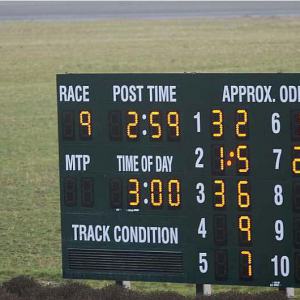Mutuel Feeling: Hold the Line
Courageous wagering doesn’t always work out
We move on from our October installment in the courageous wagering series with more win-wagering examples where the bettor is using the Kelly Criterion chart.
This month, we look at a recent and actual race that surfaced with all of the elements necessary to make it a betting race, but resulted in a loss (see the October issue for one winning example). Again, the bettor’s tools are the odds line established by the handicapper and the Kelly Criterion betting chart. Nothing else matters in the bettor’s decision to establish the need for a bet.
This race was race 1 on Aug. 24 at Yonkers Raceway. It’s a good example of a losing wagering effort that demands courage since it firmly exemplifies pari-mutuel math (betting against a huge favorite is always risky) and it borders on a pass rather than a play.
The handicapper established the following odds line. The handicapper’s percentages add to be 100 percent (odds-to-percentage equated). Then, the bettor is required to compare the handicapper’s odds-line values to the actual public offerings.
| Post | Horse | Handicapper's Odds Line | Toteboard Odds |
|---|---|---|---|
| 1 | Julio's Girl | 10-1 | 8-1 |
| 2 | Miss Machqueen | 3-1 | 5-1 |
| 3 | Grounded | 99-1 | 26-1 |
| 4 | Northern Dali | 3-2 | 1-2 |
| 5 | RD Billie | 6-1 | 6-1 |
| 6 | Arabella J | 99-1 | 47-1 |
| 7 | She Said | 25-1 | 13-1 |
| 8 | Maya Scape | 25-1 | 26-1 |
It’s important to understand that making an odds line reflects a subjective view. Therefore, it is always possible that the handicapper has not accurately assessed odds which will benefit the bettor. No handicapper possesses the talents to be consistently accurate when estimating odds for any race he or she addresses. Any discrepancies could be suspect, but the bettor never questions ones that may arise. After all, the handicapper is not trying to predict the betting public’s odds. That is the job for the morning line oddsmaker. The subjective view of the handicapper aims to sensationalize on any mistakes the public makes in the total wagering picture. Sometimes those mistakes can be vast.
In this case, the discrepancies are all in the larger odds from the handicapper’s line and the public’s wagering. The top choices are the same on both lines. The others are all outside of the window of concern, that is, they are far above 6-1, with the exception of the 5 horse, which is going off at 6-1 and is eliminated based on the betting chart, as explained in the bettor’s behavior below. Regardless of the proximity of the percentages, the bettor never second-guesses the handicapper’s odds line, even if those numbers are widely separated from the post-time odds. It is moot whether the odds are similar or not.
Now, let’s look at the bettor’s behavior. The handicapper has given the bettor three contenders (6-1 or less represents, remember, Kelly Criterion contenders). His job is to watch for which, if any, the crowd underestimates, using the betting chart as the decision-maker.
These horses are Miss Machqueen, Northern Dali and RD Billie. Scanning the $1,000-based betting chart, the bettor compares this trio’s odds line by the handicapper’s to the public’s odds line on the toteboard.
The bettor sees that Miss Machqueen is going off at 5-1 and he needs 9-2.
The bettor sees that Northern Dali is going off at 1-2 and he needs 2-1.
The bettor sees that RD Billie is going off at 6-1 and he needs 9-1.
The decision is obvious. The wager is Miss Machqueen because the bettor needs 9-2 or more to wager and Miss Machqueen is going off at 5-1.
With a $1,000 betting chart, the bettor must place $8 to win on Miss Machqueen.
With a $5,000 betting chart, the bettor must place $40 to win on Miss Machqueen.
With a $10,000 betting chart, the bettor must place $80 to win on Miss Machqueen.
The bettor logs the wager (to be delivered later to the accountant) after he wagers upon Miss Machqueen.
Miss Machqueen finished seventh, but was clearly affected by being wide from an early duel getting to the top, but only maintaining the lead to the half. Northern Dali left safely, picked up live cover and was able to use her best speed when it counted, winning by 2-¼ lengths. RD Billie gave Northern Dali the needed cover and brushed to lead at the three-quarters, but was tired from the effort and finished second. The courageous wager was to back the overlay, even though on the handicapper’s line, Northern Dali was the most likely winner with odds of 3-2. But because Northern Dali went off at 1-2 instead of the needed 2-1, it was not the courageous play here. Only Miss Machqueen provided the necessary toteboard odds to trigger a wager.
Next in this series, some quicker race examples.
by Frank Cotolo



